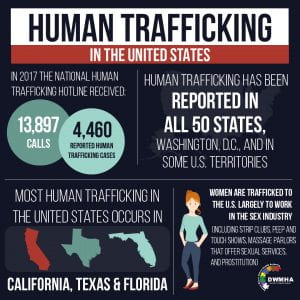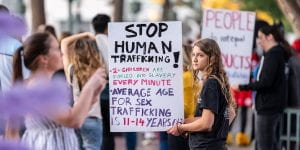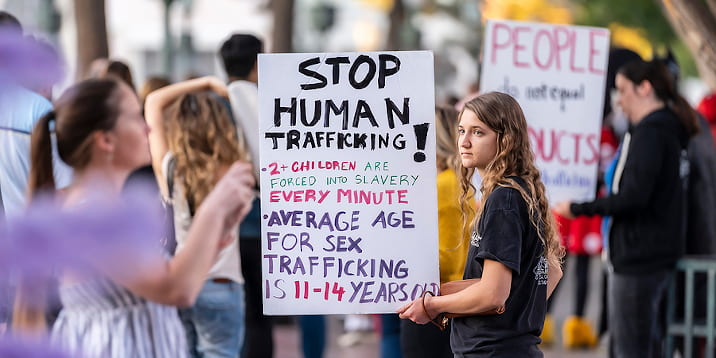It has been estimated that each year 600,000 to 800,000 men, women, and children are trafficked across international borders. November 18 was established as Anti-trafficking day by the European parliament. This day is used as an opportunity to spread and raise awareness to prevent and combat human trafficking. Human trafficking is a “crime that involves compelling or coercing a person to provide labor or services or to engage in commercial sex acts.” Any person can be a victim of human trafficking. Human trafficking is a “global problem and one of the world’s most shameful crimes.” It affects the lives of millions while also “robbing them of their dignity.” The most known form of trafficking is for the purpose of sexual exploitation, but many other victims are trafficked for the purpose of forced labor, domestic slavery, child begging, or the removal of their organs. Every country is affected by human trafficking, it is important to understand why and how this happens, and the ways to prevent it or recognize the signs.
What is Human Trafficking?
There is no single profile or defining characteristics of a trafficking victim. Victims include men, women, and children from any age and any background. Traffickers are known to often prey on individuals that come from low socioeconomic statuses. They target victims who are poor, vulnerable, in search for a better life, or are living in an unsafe or unstable situation. Trafficking victims are misled by “false promises of love, a good job, or a stable life.” They are forced into scenarios where they are forced to work under terrible conditions with little to no pay. In Birmingham, Alabama, human trafficking is a major issue. The interstate I-20 is the “most heavily trafficked stretch of interstate in the U.S.” The 140-mile road between Birmingham and Atlanta is been known as the ‘sex trafficking superhighway.’ Additionally, the intersection of I-20, I-59, and I-65 makes the city of Birmingham a central exchange for trafficking activity.

Traffickers use different methods and resources to get their victims. Physical force, threats, psychological manipulation are mostly used. Newsome Law points out that there are two general ways traffickers are able to attain victims. First, victims are lured in. Traffickers will go to the lengths to “put up a ruse that their intended victim buys into.” They will make false promises, present desired relationships, large paycheck, or another prize that will seem worthwhile. These prizes are fake, they are just used to gain attraction and attention. In some cases, it’s found that the trafficker will play along to make it believable until they have the victim with them. Secondly, another way victims are recruited is through force and coercion. Some traffickers will use threats of physical harm or actually use physical violence to get their victims. They will use weapons of physical restraints to grab the victim off the street. Tactics of threats, violence, drugging are very commonly used with either method whether they are trying to capture the victim or when they already have the victim.
Who is most at risk?
Human trafficking is important for an array of reasons. First, in the United States, some of the most vulnerable populations include people within marginalized groups. These include “American Indian/Alaska Native communities, LGBTQ+ individuals, individuals with disabilities, undocumented migrants, runaway and homeless youth, temporary guest-workers, and low-income individuals.” These conditions make these communities and individuals more at risk than they already are.
As pointed out, there is not a clear picture of who and what type of person is most at risk. Human trafficking can happen to anyone, but there are some who are more vulnerable than others.
An article by BhamNow suggested several risk factors:
- Those involved in the DHR system
- Those placed in foster or group homes
- Those with limited adult supervision
- Those with a history of trauma (including being taken from your own home which is traumatic)
- Those with a history of sexual and/or physical abuse
- Runaways / homeless youth
- Those suffering from substance abuse or with a family history of substance abuse
- Young women who learn that their body is something they can use for money
- Young men who are taught not to talk about abuse
- Queer and trans youth are also vulnerable because they often experience rejection by their families, churches, schools, and communities

What is being done to limit it
With human trafficking being a global problem, many countries and organizations have been developing tactics to prevent and protect victims from being trafficked, while also prosecuting those who traffic. In 2017, the Department of State and Labor and the U.S. Agency for International Development handles a total of 120 international counter-human-trafficking projects among 40 countries. Their projects had three goals: to prevent, protect, and prosecute. They prevented trafficking through public awareness, outreach, education, and advocacy campaigns. They protected and assisted victims “by providing shelters as well as health, psychological, legal, and vocational services. Lastly, they prosecuted human trafficking by providing resources such as training and technical assistance for police, prosecutors, and judges.
Other organizations such as the United Nations (UN) uses similar tactics to prevent, protect, and prosecute when trying to limit human trafficking. The UN started a global project called Start Freedom. This project aims to “engage and raise awareness among young people.” It empowers young people to know the signs of human trafficking and how they can prevent it from happening to them. Both projects have a common conclusion that the best way to avoid being trafficked is through education and knowing the signs.
What can we do?
It is vital to spread awareness and learn about all the risks involving human trafficking and what to do if you are being trafficked or have reason to believe someone is being trafficked.
Signs of Human Trafficking:
The National Human Trafficking Hotline provides a list to recognize if you are being trafficked or if you believe someone else is being trafficked.
How traffickers Lure people in:
- A would-be employer refuses to give workers a signed contract or asks them to sign a contract in a language they can’t read.
- A would-be employer collects fees from a potential worker for the “opportunity” to work in a particular job.
- A friend, family member, co-worker, or student is newly showered with gifts or money or otherwise becomes involved in an overwhelming, fast-moving, and asymmetric (e.g., large difference in age or financial status) romantic relationship.
- A friend, family member, or student is a frequent runaway and maybe staying with someone who is not their parent or guardian.
- A family member, friend, co-worker, or student is developing a relationship that seems too close with someone they know solely on social media.
- A family member, friend, or student lives with a parent or guardian and shows signs of abuse.
- A family member, friend, or co-worker is offered a job opportunity that seems too good to be true.
- A family member, friend, or co-worker is recruited for an opportunity that requires them to move far away, but their recruiter or prospective employer avoids answering their questions or is reluctant to provide detailed information about the job.
Recognizing Labor Trafficking:
- Feel pressured by their employer to stay in a job or situation they want to leave
- Owe money to an employer or recruiter or are not being paid what they were promised or are owed
- Do not have control of their passport or other identity documents
- Are living and working in isolated conditions, largely cut off from interaction with others or support systems
- Appear to be monitored by another person when talking or interacting with others
- Are being threatened by their boss with deportation or other harm
- Are working in dangerous conditions without proper safety gear, training, adequate breaks, or other protections
- Are living in dangerous, overcrowded, or inhumane conditions provided by an employer
Recognizing Sex Trafficking:
- Want to stop participating in commercial sex but feel scared or unable to leave the situation.
- Disclose that they were reluctant to engage in commercial sex but that someone pressured them into it.
- Live where they work or are transported by guards between home and workplace.
- Are children who live with or are dependent on a family member with a substance use problem or who is abusive.
- Have a “pimp” or “manager” in the commercial sex industry.
- Work in an industry where it may be common to be pressured into performing sex acts for money, such as a strip club, illicit cantina, go-go bar, or illicit massage business.
- Have a controlling parent, guardian, romantic partner, or “sponsor” who will not allow them to meet or speak with anyone alone or who monitors their movements, spending, or communications.

People to contact:
If you think someone is being trafficked contact:
The National Human Traffic
king Hotline: Call 1-888-373-7888 or text 233733
Call 911
U.S. Government Trafficking-Related Links:
OFFICE OF REFUGEE RESETTLEMENT TRAFFICKING EFFORTS
http://www.acf.hhs.gov/programs/orr/programs/anti_trafficking.htm
OFFICE FOR VICTIMS OF CRIME TRAFFICKING EFFORTS
http://www.ojp.usdoj.gov/ovc/help/tip.htm

